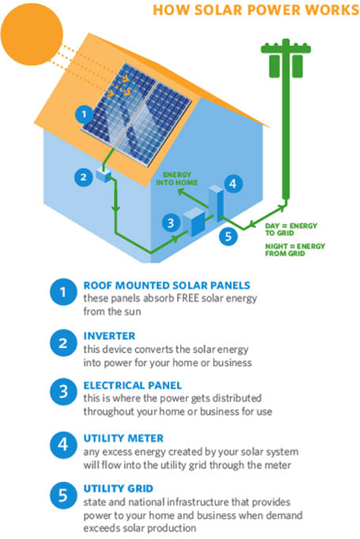 The benefits of generating electricity from solar power are tremendous. Electricity that is generated from the sun produces no harmful emissions or pollutants. With a solar energy system, you can contribute to the sustainability of the environment, reduce your energy costs for the long term and become more socially responsible.
The benefits of generating electricity from solar power are tremendous. Electricity that is generated from the sun produces no harmful emissions or pollutants. With a solar energy system, you can contribute to the sustainability of the environment, reduce your energy costs for the long term and become more socially responsible.
Components of a Solar PV System:
The major components of a solar system include the following:
• Solar Panels or Modules
• Combiner Box or Junction Box
• Inverter
• Mounting system
• AC & DC Disconnects
• Monitoring Unit
How Solar PV Works:
During the day, the solar energy system generates electricity. If there is no electrical consumption, the generated power is fed through the meter back to the utility grid. This process is called “net metering”, where any excess energy produced gets fed back into the grid, and consumers get a credit for this excess solar energy at the same price per kW that you pay for the electricity.
At night when the system is not generating energy and energy is being consumed, you begin to utilize those “credits” that you have accumulated during the day.
By properly sizing your solar system to cover your electricity usage, you can greatly reduce or totally eliminate your monthly costs for electricity.
Solar Installation:
Because of their design and function, solar energy systems are easy to install and service, requiring minimal to no maintenance. Self-contained and modular, solar panels can be designed to accommodate a variety of installation options—on the roof, ground, adjacent to building structures and on customized mounts including solar carports, pergolas and in other unique ways as fit for the application.
Why Install Solar Panels?
